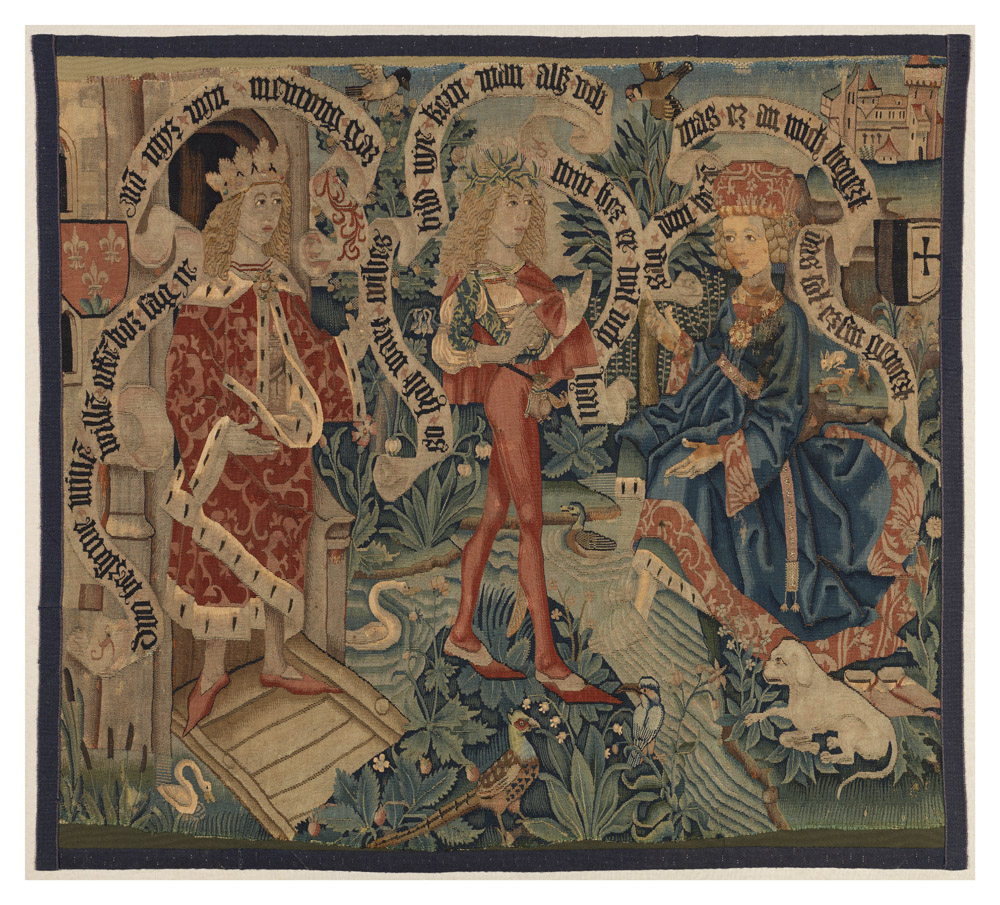Details
- Object type
tapestry panel
- Title
David and Bathsheba
- Place Associated
Alsace (place of manufacture)
- Date
circa 1480
- Materials
linen (warps), wool (wefts), linen (wefts), silk (wefts), metal (wefts), 7 warp threads per cm, 2 ply S
- Dimensions
overall: 930 mm x 1040 mm; framed: 945 mm x 1074 mm x 17 mm 24500 g
- Description
-
Tapestry panel woven with wool, linen, silk and metal thread wefts and linen warps depicting David and Bathsheba. King David in a doorway in fur-lined red voided velvet robes sends his messenger ‘Duo bezsuwe mine willen offebor sag ir von myr min meinung gar’ (‘Reveal to her my will; tell her of my intention’). The messenger in a green doublet and red hose states ‘So holt war wybes bild nye kein man alss uch min her er wil uch han’ (‘There never was a man so in love as my master; he wants to possess you’). Bathsheba in a blue gown bathing her feet in a steam responds ‘Sag dim here was er an mich Begert das sol ersin gewert’ (‘Tell your master, what he wishes from me shall be granted’). Set in a landscape with birds, swans and dog. Coat of arms for Heinrich Ingold and Clara Gerbott.
Lorraine Karafel states that: 'As Betty Kurth noted, the design is linked stylistically with a small group of tapestries woven in Alsace in the late fifteenth century, all with secular or biblical themes. These include the Burrell Collection’s closely related panel The Pursuit of Fidelity. The tapestries are all distinguished by very fine weaving and designs that reflect contemporary art in the region, particularly the engravings of Master ES and the Master of the Housebook. A reweaving of the design of the Burrell Collection’s tapestry housed in Amsterdam’s Rijksmuseum shares the same composition, but some details differ: the Rijksmuseum messenger wears garments fashionable ten to 15 years later than those in the Burrell panel; he wears a short, loose cloak and his shoes now have rounded fronts. The speech scrolls, too, offer a different conversation: in the Rijksmuseum panel, the king bids the messenger to tell Bathsheba ‘good news of her husband Uriah’, which the lady is delighted to hear. With changed words, the two tapestries’ messages are significantly altered: the Burrell piece emphasizes desire and acceptance while the Rijksmuseum example highlights wifely fidelity, and warns against adultery.' (Cleland, E. and Karafel, L., (2017). Glasgow Museums: Tapestries from The Burrell Collection, 98).
Provenance: Commissioned by Heinrich Ingold and his wife Clara Gerbott, Strasbourg; Le Carpentier, France; Catalogue des objets d’art et de curiosité, tableaux anciens, composant la collection de feu M. Le Carpentier, Hôtel Drouot, Paris, 14 May to 2 June 1866, lot 1421: ‘Petite tapisserie du XV siècle: Louis d’Orléans demandant la main d’Anne de Bretagne pour Charles VIII ... ’; Petit de Vauzelles, Saint Symphorien; EJ Wythes, London; Catalogue of fine tapestry, English and French furniture, porcelain and objects of art, the property of E. J. Wythes, CBE, removed from 40 Berkeley Square, WI and Copped Hall, near Epping, Essex sale, Christie, Manson & Woods, London, 21 November 1935, lot 149 (illus.); from where purchased by Sir William Burrell, 23 November 1935, for £1,837.10.0.
- Credit Line/Donor
Gifted by Sir William and Lady Burrell to the City of Glasgow, 1944
- Collection
Burrell Collection: European Tapestries
- ID Number
46.27
- Location
Burrell Collection
